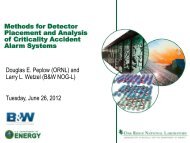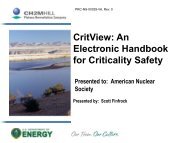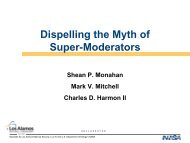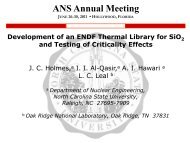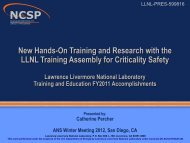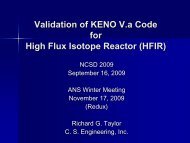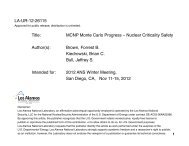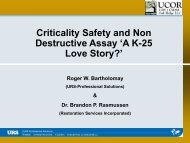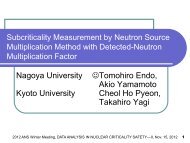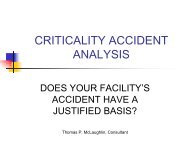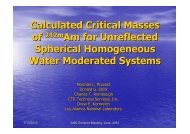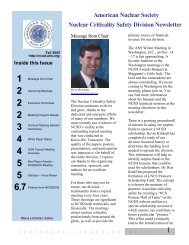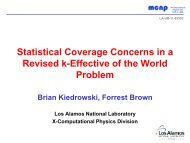Fall - Nuclear Criticality Safety Division - American Nuclear Society
Fall - Nuclear Criticality Safety Division - American Nuclear Society
Fall - Nuclear Criticality Safety Division - American Nuclear Society
Create successful ePaper yourself
Turn your PDF publications into a flip-book with our unique Google optimized e-Paper software.
Subcritical Measurements of a Plutonium Sphere with Various Reflectors, Jesson Hutchinson (Georgia Tech)A Dynamic Simulation Tool for Critical Assemblies Using the Coupled Neutronic-Thermoelastic Method,Travis Grove, Robert Kimpland, William L. Myers (LANL)Data, Analysis, and Operations for <strong>Nuclear</strong> <strong>Criticality</strong> <strong>Safety</strong>—II, sponsored by NCSD; cosponsored byYMG.The TWPC Graded-Approach to <strong>Nuclear</strong> <strong>Criticality</strong> <strong>Safety</strong>, Kevin Kimball (NISYS Corp)<strong>Criticality</strong> Frequency Analysis for De-Inventory of Lawrence Livermore National Laboratory’s Special <strong>Nuclear</strong>Materials to Savannah River Site, Debdas Biswas, David Riley, Karen Dodson (LLNL)Approach for <strong>Nuclear</strong> <strong>Criticality</strong> <strong>Safety</strong> During Demolition of the K-25 Building, John Chandler (ACTS ofSouth Carolina), Roger W. Bartholomay (WSMS)Subcritical Measurements Multiple HEU Metal Castings, John Mihalczo (ORNL)Using Cross-Section Uncertainty Data to Estimate Biases, Donald Mueller, Bradley T. Rearden (ORNL)Designing Critical Experiments in Support of Full Burnup Credit, Jeremy A. Roberts (Univ of Wisconsin,Madison), Donald Mueller (ORNL)Data, Analysis, and Operations for <strong>Nuclear</strong> <strong>Criticality</strong> <strong>Safety</strong>—III, sponsored by NCSD; cosponsored byYMG. Session Organizer: Nichole Ellis (Ellis <strong>Nuclear</strong> Eng)MCNP5 <strong>Criticality</strong> Benchmarking Using ENDF/B-VII.0 for LEU Systems, John Hannah, Qi Ao, John Zino(GE-Hitachi <strong>Nuclear</strong> Energy)Efforts to Eliminate Raschig Ring Filled Vessels at B&W, Ron J. Green (Babcock and Wilcox NOG-L)Variation of Extrapolation Distance with U-235 Concentration, Allison Miller, Robert D. Busch (Univ of NewMexico)The Quantitative Relevance of Correlation to the Independence Aspect of the Double Contingency Principle,Burton Rothleder (DOE)Performance of the New Continuous Energy Capability in KENO V.a, Sedat Goluoglu (ORNL)Recent <strong>Nuclear</strong> <strong>Criticality</strong> <strong>Safety</strong>–Related Events and Associated Lessons Learned, sponsored by NCSD;cosponsored by YMG.<strong>Criticality</strong> <strong>Safety</strong> Issued Related to Use of Raschig Rings at B&W, Larry L. Wetzel (B&W <strong>Nuclear</strong> OperationsGroup)Plants Changes Effecting <strong>Criticality</strong> Alarm Exemptions at NRC Licensees, Thomas J. Marenchin, DennisMorey (U.S. NRC)Importance of <strong>Criticality</strong> <strong>Safety</strong> Staff Monitoring and Reviewing Procedures Used to Perform Fissile MaterialOperations at NRC Licensees, Thomas J. Marenchin, Dennis Morey (U.S. NRC)<strong>Nuclear</strong> <strong>Criticality</strong> <strong>Safety</strong> Lessons Learned at Los Alamos National Laboratory, Douglas G. Bowen, Shean P.Monahan (LANL), Patrick Moss, Jerry Hicks (U.S. DOE/NNSA)March 6, 2006 Spill Event at <strong>Nuclear</strong> Fuel Services, Randy Shackelford (<strong>Nuclear</strong> Fuel Services, Inc.)<strong>Nuclear</strong> <strong>Criticality</strong> <strong>Safety</strong> Standards Poster Session, sponsored by NCSD; cosponsored by YMG.Administrative Practices for <strong>Nuclear</strong> <strong>Criticality</strong> <strong>Safety</strong>, Royal W. Carson Jr. (NISYS Corp)ANSI/ANS-8.23-2007: <strong>Nuclear</strong> <strong>Criticality</strong> Accident Emergency, James Baker (LANL)<strong>Criticality</strong> <strong>Safety</strong> Engineer Training and Qualification Program –ANSI/ANS-8.26, James Morman (ANL)Overview of the Raschig Ring Standard, ANSI/ANS 8.5, Jerry Hicks (U.S. DOE NNSA)ANSI/ANS 8.24 - Validation of Neutron Transport Methods for <strong>Nuclear</strong> <strong>Criticality</strong> <strong>Safety</strong> Calculations, RobertD. Busch (Univ of New Mexico)ANSI/ANS-8.1: <strong>Nuclear</strong> <strong>Criticality</strong> <strong>Safety</strong> in Operations with Fissile Material Outside Reactors, Douglas G.Bowen (LANL), Nicholas Brown (<strong>Nuclear</strong> Fuel Services)ANSI/ANS-8.15: <strong>Nuclear</strong> <strong>Criticality</strong> Control of Selected Actinide Nuclides, Charles Rombough (CTRTechnical Services)ANSI/ANS 8.12, <strong>Nuclear</strong> <strong>Criticality</strong> Control and <strong>Safety</strong> of Plutonium- Uranium Fuel Mixtures OutsideReactors, Debdas Biswas (LLNL), Dennis Mennerdahl (E M Systems)5
2. <strong>Nuclear</strong> <strong>Criticality</strong> <strong>Safety</strong> Standards Forum – PanelSubcommittee ANS-8, Operations with Fissile Material Outside Reactors, meets to discussvarious technical and administrative aspects of the approximately 20 national consensusstandards under its purview. In addition to status and progress updates by representatives ofindividual working groups, formal presentations on the technical bases of numerical values suchas subcritical limits and experiences with applications of particular standards are solicited.Agenda topics such as new and expanded standards are also encouraged.Session Organizer: Tom McLaughlin, LANL-retired3. Advances in <strong>Nuclear</strong> <strong>Criticality</strong> Accident Excursions Analysis – ContributedThe need for excursions analysis is evident when developing both minimum accident andbounding accident scenarios apart from default methods or generic handbook values. Thissubject area is broad and can consider the computational advances and practical applications ofthose methods. Recent advances in multiphysics computation can also be addressed.Additionally, the use of time dependent simulation studies for source term and evacuation studiescan also be addressed. This session will provide the opportunity to present papers relative toadvances in nuclear criticality accident excursions analysis.Session Organizer: Peter Angelo, Y-124. <strong>Nuclear</strong> <strong>Criticality</strong> <strong>Safety</strong> Staff and Operations Interface – ContributedA good interface between the staff providing limits and controls for safe fissile materialoperations and the staff with operation’s responsibilities is essential for a sound program. Asignificant fraction of nuclear facilities have added the position of a <strong>Criticality</strong> <strong>Safety</strong> Officer (orRepresentative) to manage or strengthen this interface. This session will focus on the interfaceissue, the problems that lead to this new position, experience with this initiative and possibilityother ways of positively addressing the interface objective.Session Organizer: Bob Wilson, DOE5. Integration of <strong>Nuclear</strong> <strong>Criticality</strong> <strong>Safety</strong> into New Facility Design – ContributedDOE/NNSA and NRC licensees are designing and constructing new fissile material processes inthe United States. These include new enrichment facilities, new waste uranium recoveryfacilities, new uranium storage and processing facilities and plutonium research and developmentfacilities. Integrating nuclear criticality safety into the design process is an important element ofeffective nuclear criticality safety programs. Robust NCS design criteria and early input fromcriticality safety engineers enable the designers to build upon collective knowledge and lessonslearned from the “ground up”. This technical session will explore various approaches to establishfissile material process design criteria and provide practical applications. Documentation of NCSdesign criteria, philosophies, or principles applied to the design of new facilities are reviewed.Implementation of current regulations, standards, or procedures to real world facility designpractices and principles are presented.Session Organizers: Lon Paulson, GE-Hitachi <strong>Nuclear</strong> Energy and David Hayes, LANL7
NCSD 2009<strong>Nuclear</strong> <strong>Criticality</strong> <strong>Safety</strong> <strong>Division</strong> Topical MeetingSeptember 13-17, 2009 Richland, Washingtonhttp://www.ncsd2009.comTechnical ProgramThe following general subjects are proposed for the technical program:Realism and <strong>Criticality</strong> <strong>Safety</strong>:Input dataCross sectionsModelingAccident scenariosApplications and Realism:Benchmark selectionTsunami and other methodsSub-critical MeasurementsBurn-up credit applicationsRobustness in controls:Development of <strong>Criticality</strong> ControlsRequirements documents DOE, NRCStandards roleImplementation of <strong>Criticality</strong> ControlsExamplesInternational experiencePanel discussion: “Are We Ready?”Ready for the Renaissance:Status and scope of GNEP<strong>Criticality</strong> safety needs for the fuel cycle(enrichment, fabrication, transportation,storage and disposal)Harvesting existing benchmark data (fuelcycle and nuclear data)In-situ measurements<strong>Criticality</strong> safety and engineering designUse of computers in operations controlsPeople needs, training and educationAdditionally, there are at least 3 workshops planned for the Topical on MCNP, SCALE, andDICE (ICSBEP Database).NCSD Sessions for the2009 ANS Winter Meeting in Washington DC1. Data, Analysis, and Operations for <strong>Nuclear</strong> <strong>Criticality</strong> <strong>Safety</strong> – ContributedThe purpose of this session is to provide a forum for timely presentation of general issues in thearea of nuclear criticality safety that are not covered in other special session topics.Session Organizer: Nichole Ellis, Ellis <strong>Nuclear</strong> Engineering LLC2. <strong>Nuclear</strong> <strong>Criticality</strong> <strong>Safety</strong> Standards Forum – PanelSubcommittee ANS-8, Operations with Fissile Material Outside Reactors, meets to discussvarious technical and administrative aspects of the approximately 20 national consensusstandards under its purview. In addition to status and progress updates by representatives ofindividual working groups, formal presentations on the technical bases of numerical values such8
as subcritical limits and experiences with applications of particular standards are solicited.Agenda topics such as new and expanded standards are also encouraged.Session Organizer: Tom McLaughlin, LANL-retired3. Highlights from the NCSD2009 Topical Meeting - ContributedThis session is intended to capture presentation highlights from the NCSD2009 Topical Meeting,September 13-17, 2009. A set of highlight papers from the Topical will be selected based on thereview of full paper contributions to the Topical meeting. The authors of these papers will benotified and asked to participate in this session. The presentations at the National (Winter’09)meeting will include updates based on audience feedback and commentary. The selected paperswill address the following technical subject areas: Realism in Benchmark Selection andModeling Assumptions; Realistic <strong>Safety</strong> Margins; Robustness in the Development of <strong>Criticality</strong>Controls; Realism in the Application of the Double Contingency Principle; <strong>Criticality</strong> <strong>Safety</strong>Needs to Support the Global Renaissance of <strong>Nuclear</strong> Power, including training, education andworkforce needs. This session will bring the highlights of the Topical Meeting to a more diverseaudience.Session Organizer: Michael Brady-Raap, PNL4. Improvements in <strong>Nuclear</strong> <strong>Criticality</strong> <strong>Safety</strong> Controls - ContributedOne of the objectives of NCS is to establish controls that are not likely to fail. This includesutilization of technology, training, and changes in equipment design to make the mesh thecontrols with the normal operations. The objective is to make it easy to do it right and hard to doit wrong. In this session, papers should focus on how NCS controls have been improved ordeveloped to improve the robustness of the controls. Specific examples would be beneficial.Session Organizer: Larry Wetzel, B&WAlso, at the 2009 ANS Winter Meeting there will be an Embedded Topical for the YoungMembers Group and the NCSD has the following session as part of the YMG Topical:Next Generation of <strong>Nuclear</strong> <strong>Criticality</strong> <strong>Safety</strong> Professionals – ContributedThe nuclear criticality safety discipline is faced with competing demands of growth in thenuclear power industry; namely, how do we assure an adequate talent pipeline to maintaincurrent and future staffing needs at existing and planned new fissile process facilities? Thissession encourages current practitioners to provide information about facility-specific resourcesused to train and qualify new NCS staff. This session also encourages practitioners to provideexamples of NCS work experiences including (but not limited to) advancements in methods,criticality safety analyses format / content improvements, controls flowdown to operationspersonnel, and NCS training awareness program improvements. New or prospective criticalitysafety practitioners are encouraged to participate to learn about the diverse skill sets required inthis important discipline and the resources available to facilitate developing that expertise.Session Organizers: Lon Paulson, GE-Hitachi <strong>Nuclear</strong> Energy and Mikey Brady Raap, PNL9
Education CommitteeSedat Goluoglu, Education Committee Chairgoluoglus@ornl.gov(865) 574-5255The Education Committee met at the Reno meeting. There are currently five approved WhitePapers. They are listed below.TopicRevisionEducation Committee Overview Revised 6/06 (Rev 0)Definition of a CSE Specialist Revised 6/06 (Rev 0)Successful NCS Mentorship Program Revised 6/06 (Rev 0)Acceptable Evaluation of NCS Revised 6/06 (Rev 0)<strong>Nuclear</strong> <strong>Criticality</strong> Accidents In The Workplace: Fact Sheet Revised 6/06 (Rev 1)One White Paper was withdrawn, “CSE Specialist Training & Qualification,” since ANSI/ANS-8.26 has been issued. There is one White Paper that is out for comment until December 31,2008. The title is “Realism in the Assessment of Fissionable Material Operations OutsideReactors.” You can review it on the NCSD website, and provide comments to David Hayes orSedat Goluoglu.NCSD Awards DinnerMaria LeTellier, Awards Committee Chairletellierms@y12.doe.gov(865) 241-3458The NCSD Awards Dinner was held at the Silver Peak Restaurant and Brewery. Approximately75 people attended. In fact, we had more people than the restaurant could accommodate in theirbanquet hall, so they moved us to the main dining area. A social was held from 6 – 7 pm. Thedinner was held at 7 pm followed by the award ceremony.Two <strong>Division</strong> awards were presented at the Winter meeting in Reno, NV. The citations areshown below:TECHNICAL EXCELLENCE AWARDDr. Richard D. McKnight was recognized in the area of ENDF <strong>Nuclear</strong> Data testing andvalidation. Dr. McKnight worked in this field for several decades and served as a committeechair for much of that time. He was involved in the pre-analysis and post-analysis for severalArgonne National Laboratory critical experiments and has subsequently evaluated and/or10
eviewed several ZPR and ZPPR experiments for the International <strong>Criticality</strong> <strong>Safety</strong> BenchmarkEvaluation Project (ICSBEP), thus making them available to the criticality safety community.As chair of the <strong>Nuclear</strong> <strong>Criticality</strong> <strong>Safety</strong> Program's (NCSP) <strong>Nuclear</strong> Data Advisory Group, Dr.McKnight has helped focus several elements of the NCSP and has helped shape the critical /subcritical experiment design effort. Dr. McKnight's dedication, expertise, attention to relevantdetail, and gifted problem solving and decision-making abilities has earned him the respect ofnearly everyone with whom he associates. He is an example of technical excellence and amentor to all who will listen. With these experiences and skills, Dr. McKnight has become aleader in the international criticality safety and nuclear data communities.DISTINGUISHED SERVICE AWARDCalvin M. Hopper was recognized for distinguished service to the <strong>Division</strong> in governance,standards, and international work. Calvin Hopper has been a practicing nuclear criticalityspecialist for over thirty years. He has served in all of the NCSD governance roles and chairedthe 2005 NCSD topical meeting. Calvin currently chairs N-16 and serves on the ANS StandardsBoard. Additionally, he has served as convenor of ISO/TC-85/ SC-5/WG-8 for many years andcurrently serves as the Overall U.S. Advisor for ISO/TC-85/SC-5. He has also been secretary ofANS-8, chair of ANS-8.7 and member of ANS-8.1, -8.20, -8.23 and -8.26.During his professional career, Mr. Hopper served as the co-chair of the NCTSP and had a majorrole in the design and implementation of the NCSP as the DOE response to DNFSBRecommendation 97-2. Currently he serves as the deputy chair of the NCSP CSSG, and hedeveloped and led the NCSP AROBCAD Sensitivity/Uncertainty Methods Work Element.Dr. Richard McKnight, holding his awardplaque. Jim Morman, Award subcommitteechair, is shown at right.Calvin Hopper, accepting his award fromMaria LeTellier, Awards committee ChairNominations are being sought for both of these awards for next year. Information on the awardsis available on the NCSD website http://ncsd.ans.org/site/awards.html. Nominations andquestions should be sent to Maria LeTellier.In addition, two best paper awards were presented:11
Larry L. Wetzel for his paper entitled <strong>Criticality</strong> <strong>Safety</strong> Calculational Issues of LooselyCoupled Systems, presented at the ANS 2007 Winter Meeting in Washington, D.C.Kevin Kimball, for his paper entitled Impact of NDA Uncertainties on NCS at the K-25Site, presented at the ANS 2008 Summer Meeting in Anaheim, CA. Kevin’s other paperat that meeting was a close second-place!The best paper awards are presented based ontabulation of scoring ballots distributed toeveryone attending the NCSD sessions. Yourvote counts, so always hand or mail in yourballots when you attend sessions. The awardscommittee is looking for a member to helpwith administering these best paper awards. Ifinterested, please contact Maria LeTellier.NCSD Website NewsThe NCSD website is coming back to life.Some of the changes include under theMeetings link are the information on upcomingmeetings along with a summary of the Renomeeting. Some of the presentations from theReno meeting are available on the same page.A page with pictures from Reno is linked offthe MEETINGS page.Nicole Ellis (left), Program CommitteeChair, presenting best paper award to KevinKimball. Larry Wetzel, the other best paperawardee is shown in the background.Check out the NCSD website, and while there, enter or update your information on the AddressBook. If you have suggestions for the website, send them to Larry Wetzel(llwetzel@babcock.com).12



